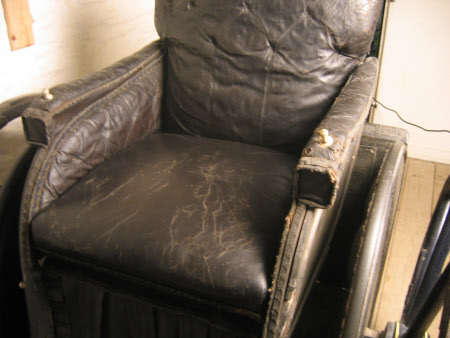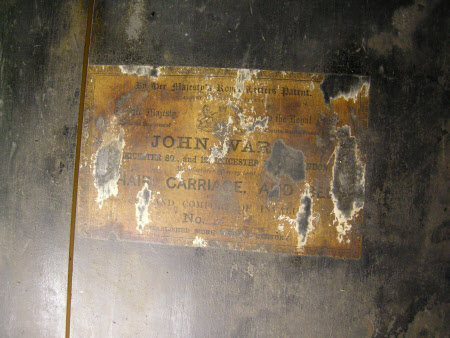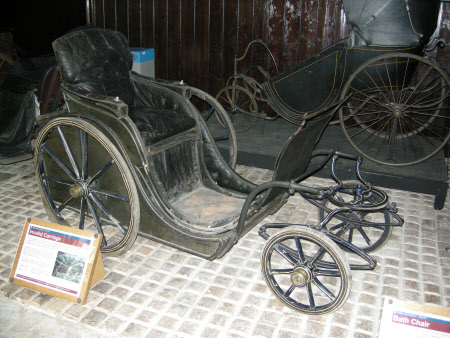Invalid carriage
Category
Carriages & other vehicles
Date
1870
Materials
Bone, Leather, Rubber, Textile, Wood
Measurements
1270 x 1120 mm; 2140 mm (Length)
Order this imageCollection
National Trust Carriage Museum
NT 272870
Summary
4-wheeled, rubber shod, Invalid Carriage built by John Ward of Leicester Square, London about 1870, and owned by the Marquis of Bute. In a livery of blue, with yellow lining, and black leather interior trim and one cushion. A very low four wheeled carriage with hinged tailboard that forms a ramp so that a bath chair can be wheeled into it. The chair that is fitted has no wheels and cannot be original because if it had wheels it would be too wide and long to fit inside. However both were made by John Ward of Leicester Square.
Full description
4-wheeled, rubber shod, Invalid Carriage built by John Ward of Leicester Square, London about 1870, and owned by the Marquis of Bute. In a livery of blue, with yellow lining, and black leather interior trim and one cushion. A very low four wheeled carriage with hinged tailboard that forms a ramp so that a bath chair can be wheeled into it. The chair that is fitted has no wheels and cannot be original because if it had wheels it would be too wide and long to fit inside. However both were made by John Ward of Leicester Square. Built by J. Ward of Leicester Square, London, this carriage, painted in the colours of the 7th Marquis of Bute would appear to have been specially built to accommodate an invalid chair, which can be wheeled into it up a hinged ramp at the back. The wheels are no longer fitted to the chair. A small pony, driven by the invalid, would draw the carriage. The wrought iron shafts are, unusually, in the shape of a wishbone. National Trust Guidebook (Hugh McCausland) This little carriage is a most unusual one, probably locally made. Drawn by a pony, it is in fact two separate things consisting of a seat which could be taken out and carried, fitted into a little four-wheeled carriage. Its uses for an elderly or infirm person in such a park as Arlington are obvious. BODY Very low body with straight bottom line only 7 ins above the ground. Panelled tailboard with bottom hinges. (chair) Cut-under body of curved form hinged back rest the angle of which can be controlled by two knobs that engage spring bolts in brass quadrants. Fittings for adjustable footrest (missing). Doors None Steps None Windows None Lamps None External Furniture Brass furniture CARRIAGE Wheels Eight and ten spoke English pattern wheels with no spoke stagger and conventional felloes, solid rubber tyres in teh firm of bands which fit between plates screwed to the inside and outside surfaces of the felloes. (chair) Wheels and axles missing. Axles Grease axles of a type peculiar to invalid carriages. Front axle compassed up. Hind axle cranked down approx 10 ½ ins. Springs Two plate elliptic springs in front, no springs behind. Fore carriage All iron forecarriage with scrolled transom and horn bar attached to curved stays from front of body. Axle bed reflects the shape of the transom. Full double wheel-plate, lug attached to bottom wheel plate to carry iron wishbone shafts (missing). Perch None Hind carriage None Brake None Paint Body possibly dark blue but colour concealed beneath decayed varnish. Wheels and forecarriage dark blue lined yellow. (chair) As above fine yellow lines on body panel beads and fram of seat back. Heraldry (chair) Monogram CB beneath Marquess coronet on both side panels. Leather Inside surfaces of side panels covered with padded and buttoned leather cloth with stitched seams in the shape of a wheel. With dark blue edging laces around all inside edges. (chair) Leather dashboard with remains of leather serving on mounting handles and rein rail. External Trimming (chair) Side squabs, arm rests and seat rack buttoned dark brown morocco. Sprung seat cushion dark brown leather cloth. Pleated seat fall dark brown morocco. Dark blue worsted seaming and pasting laces. Patterned floor cloth with stencilled pattern very deteriorated. Ivory studs to locate apron – missing. Internal Trimming Internal Furniture
Provenance
this vehicle is the smallest of a collection of 8 horse-drawn carriages originally the property of the Marquis of Bute and given to The National Trust by the Museum of Wales. Owned by the Marquess of Bute family. In 1947 the 5th Marquess of Bute donated ten carriages to the National Museum Wales (then Welsh Folk Museum), without any conditions attached to the donation. In 1948, when the Welsh Folk Museum opened two of the carriages were put on display in their coach house, but they could not display the other carriages, which were put into storage. In January 1964 the 6th Marquis of Bute suggested that the carriages in store could be given to the National Trust to help establish the carriage collection at Arlington Court. As the carriages were in the ownership of the NMW they arranged for the unconditional transfer of 8 carriages to Arlington Court.



